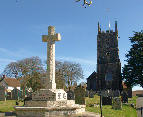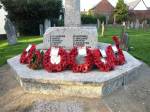John Thomas Lane was born in 1877 in Parkham, Devon. His father, Thomas, was a stone mason, born in 1855 in Alwington, who married Susanna Packard (born 1840) in Parkham. John was the youngest of five children and the only boy, who went through the elementary school system to become a school teacher. He was among the first generation of children to experience compulsory education as a result to the education act of 1870 which provided for a system of Board Schools in those parts of the country where the schools organised by either the Church of England or the Nonconformist churches were not sufficient for the population.
John Lane then moved on from his childhood experiences to become a pupil teacher himself. The route into the profession of elementary school teacher began early. From the top standard class of pupils aged 13, or 14 if they stayed on the extra year after the school leaving age, a pupil could become a 'Pupil Monitor', taking charge of a class as best he or she could manage, and passing on a lesson under the overall direction of the Master. It was a system designed to save money by avoiding the employment of junior teachers, but there is no doubt that in most cases the young monitors had to struggle with keeping order in large classes of children hardly a year or two younger than themselves. From Monitor the next step was promotion to Pupil-teacher, a form of apprenticeship on a tiny salary. Besides a full day of teaching the pupil was expected to follow a course of instruction by the Head Teacher in the evenings, part of his contracted duties. The quality of instruction and guidance must of course have varied from school to school. An alternative route was via a Boys' department correspondence course, but of course fees had to be paid to the Correspondence College in this case. Following exams in reading, writing, basic arithmetic and drawing, a good reference would ultimately qualify the pupil teacher for entrance (as an uncertified teacher) to a teacher training college and the qualification of Certified Teacher. He or she could then expect to be appointed deputy Master of a large school or Master of a smaller school. Some, of course, like Sarah Tipper at Winkleigh School, never progressed beyond the statu of Uncertified Teacher. Married to the Master, John Tipper, she had taken over the Infants class and remained at the school long after his death, retiring only in 1921, and even then returning for a few months to help her daughter begin her career.
The 1891 census shows that John Lane was a school monitor. Ten years later in 1901 he had passed though the stage of pupil teacher, and was already a Certified Teacher in Portsmouth at the Albert Road School, Southsea, which had opened its doors in 1875, but since he is not listed on the school strength he probably was there for only a short time.
In common with all large towns and cities, the 1870 Education Act had presented the huge task of building and staffing enough elementary schools to educate the very large numbers of children who did not attend the church schools and who were indeed growing up illiterate. Portsmouth Town Council received a report that showed that more than 8,000 such children lacked school accommodation, and there was a rush to elect a school board for the borough in January 1871 and to begin by providing a Boys’ Department at the Swan Street Lancastrian School. During 1872 three new Board Schools were being built, and by 1880 twelve entirely new schools had opened. 9,000 school places were now available, but 2,000 more places were still needed. Clearly this was a golden era of opportunity for all those young men and women entering the teaching profession.
Before taking over as the Master of Winkleigh School, therefore, John Lane had gained his experience at a much larger school designed to cater for 218 boys, 218 girls and 298 infants. In 1906, at the age of 29 he and Emma, together with two-year-old Lillian, moved to Winkleigh for John to take over from the legacy left to the village by John Tipper, who had sadly died of influenza. John Lane took up his duties on December 3rd 1906 and apart from his very short period of military service he served the school and Winkleigh with great devotion until 1922.
The log books record the immense difficulties of this work, particularly during the war. The staffing situation was tolerable before 1914, though there were far too few certified teachers to help him, and the classes were being taken by pupil-teachers and even monitors. For example, the school year which began in February 1908 was staffed by Lane (Master), Sarah Tipper (uncertified teacher for the infants) David Tipper, Elizabeth Lock and Alice Cann (Pupil Teachers) and Millie Inch (Probationer) - all this for classes of Infants, Standards 1-4 and a Standard 5 class for those who stayed on after 14. Classes, however, were below average by the standards of the day where classes of 50 children or more were common in city schools. In September 1911 at Winkleigh it is recorded that there were 31 infants in Standard 1, 29 in Standard 2, and 30 in Standard 3. For the year 1912-13 staffing was no better. Frank Burgoyne, was on the staff as an uncertified teacher as deputy Head, and boarding in the School House. He was joined by Sarah Tipper and Elsie Letheren (monitoress) with two short-term supply teachers to make up the balance - Eva Thorne (supply supplementary) and a Miss Pertherick from Spreyton school. The year 1914-15 records John Lane admitting 'struggling' to staff classes now listed as Standards 1-7. Frank Burgoyne had left to move to Okehampton. This left only Sarah Tipper and two uncertified supply teachers, one of who arrived on March 3rd and stayed only for 10 days! On April 12th 1915 it was recorded that 'only three responsible teachers are considered necessary for the school year 1915' totalling John Lane, Sarah Tipper (infants and Standard 1) and Ellen Melhurst - who was put in charge of years 2 and 3 as well as the girls' needlework classes. This would have left John Lane to run the school and teach full time the standards 4, 5 together with the remaining 6 and 7 pupils at the same time. There is no record of any monitors, so it is difficult to see how the Master could have coped with staff absence.
When war came it is obvious that John Lane was far too involved with the school to consider enlisting, and at 37 he was beyond the age of thinking of doing so. However, by the end of 1915 the old British army was gone, the Territorials were fully engaged and Kitchener's New Army battalions were already serving - indeed, the first batch of these volunteers had already been killed in September at Loos. New recruits were now coming forward in far fewer numbers, and a crisis loomed. On 11 October 1915 Lord Derby was appointed Director-General of Recruiting. He brought forward a programme five days later, often called the Derby Scheme although its official title was the Group Scheme, for raising the numbers. Men aged 18 to 40 were informed that under the scheme they could continue to enlist voluntarily or attest with an obligation to come if called up later on. The War Office notified the public that voluntary enlistment would soon cease and that the last day of registration would be 15 December 1915. Those who had not registered by that date would face conscription.
The Winkleigh School log books record John Lane's entry for December 13th 1915: 'Today I attested for the Derby scheme'. He was 38 years old and as at his medical he was found unfit for front line service, he was placed in Group 45 for an eventual call-up. He was called for a medical re-examination on May 21st 1918, also recorded in the log book. He was eventually called up for service on August 2nd 1918, with Mr. H.W. Bourne taking over as temporary Master. John Lane was therefore serving for only three and a half months of the war, and did not go overseas. There is no extant medal card and his military documents did not survive the London blitz.
John is recorded on the Winkleigh Roll of Honour as serving in the Glamorgan Yeomanry. The days were long gone when recruits would have been given a posting to a local county regiment: men were simply allocated to fill slots as they were needed although 'Derby men' were in theory allowed to choose their preferred unit. There is a clue, however. John Lane might well have been a keen cyclist. His health was not of the best an he might well have enjoyed this form of exercise - cycling was immensely popular at the time, particularly in rural areas because of the freedom and mobility it afforded. The Glamorgan Yeomanry was a very small regiment, so a second line regiment was formed in 1914. In January 1915 it joined the 2nd/1st South Wales Mounted Brigade in the Dorchester area. Then, in July 1916 the existing 2nd Line yeomanry units were re-organised, all becoming cyclist battalions. By 1918 the 2nd/1st Glamorgan Yeomanry were at Worlingham near Lowestoft serving in the 1st Cyclist Brigade on home service duties. It is more than likely that John Lane was among them, having exercised his right of choice.
With the end of the war the staffing situation and the general standards of education in Devon gradually improved and it was a very different school that John Lane left behind him when he finally moved on to become the Master of Hatherleigh School on July 24th 1922. He was replaced for a few months by Walter Light, sadly unable to manage, and the school fell into a very bad state. However, on January 23rd he was replaced by George Symons, under whom, as the log book records, 'The wholesome conduct of the school was restored.'
16th August 2018


